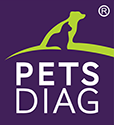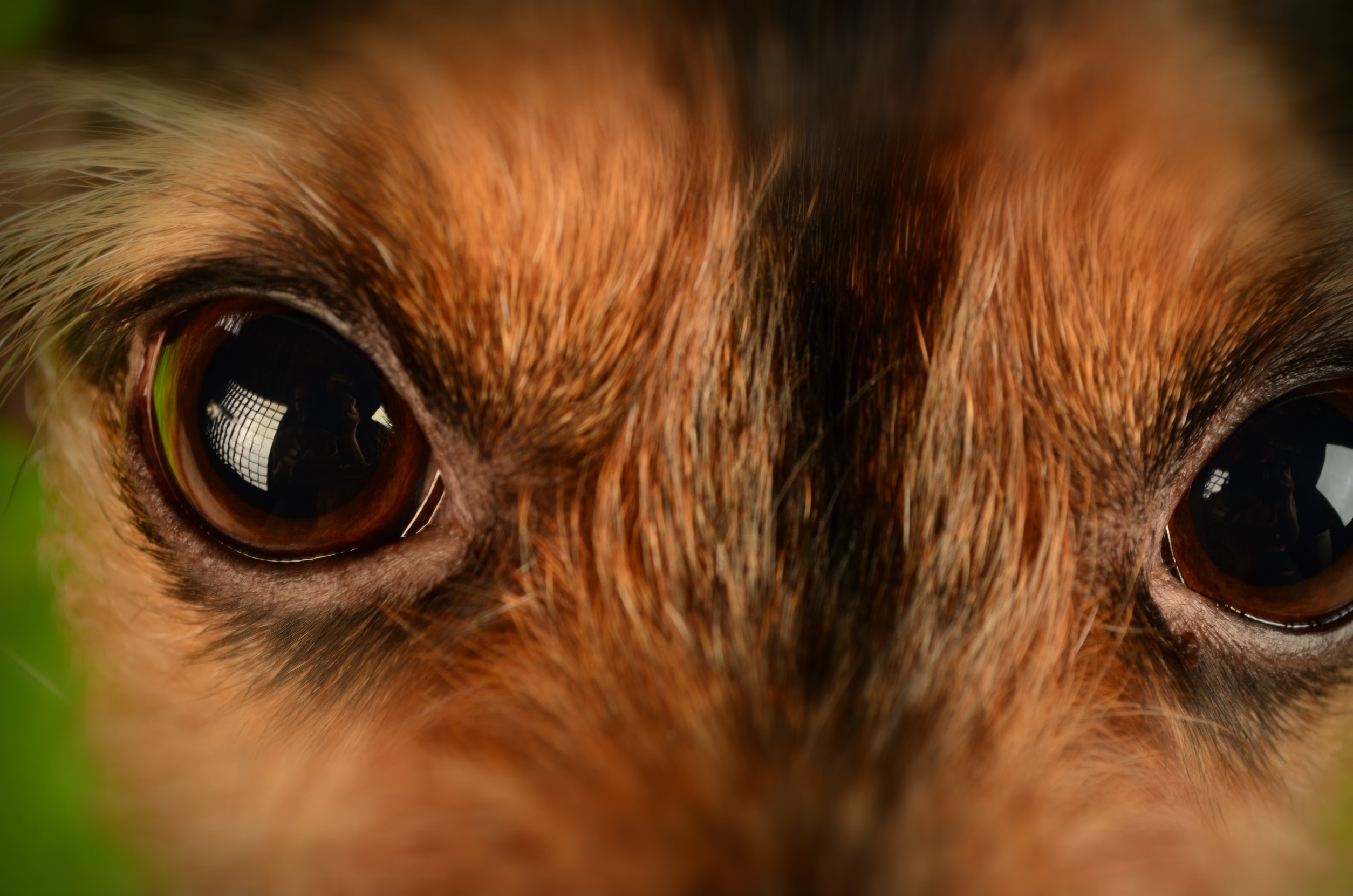Sight is one of the key senses to obtain information from the outside world. Dogs, like humans, experience age-related changes in their eyesight. Retinal degeneration and lens clouding are common problems in older dogs. Vision problems can also have other causes. The cause may be an abnormal structure of the eye, genetic disease, trauma, but also many diseases, incl. diabetes. As in other ailments, prophylaxis is very important, which, in the case of congenital defects, may not stop the disease, but will allow us to detect it, inhibit its development and alleviate symptoms. The main preventive measure is, of course, regular checkups at the vet. Symptoms that should worry the owner are all kinds of discharge from the eyes, rubbing the eye area with its paws, as well as disturbances in the process of vision. If this type of behavior is noticed, the guardian should immediately go to the veterinarian with the dog. What else can we do to take care of our four-legged friend? A proper diet is also helpful.
WHICH SUPPLEMENTS TO TAKE CARE OF OUR DOG’S EYESIGHT?
These include vitamins A and C, zinc, selenium, chromium, and taurine, which are nutrients that support the functions of the retina and the eye lens. Although supplementation to improve eyesight in dogs is not so common yet, it can certainly be confirmed that the administration of appropriate minerals, vitamins, and amino acids, especially to older dogs, has a positive effect on their eyesight.
Human studies have shown that dietary lutein, zeaxanthin and β-carotene, and other antioxidant ingredients such as vitamins C and E, reduced the risk of eye diseases such as age-related macular degeneration and cataracts [1]. Similarly, in dogs, an improvement in the functioning of the eye was found after the addition of antioxidants (lutein 20 mg, zeaxanthin 5 mg, β-carotene 20 mg, astaxanthin 5 mg, vitamin C 180 mg, vitamin E 336 mg / day) used for 6 months [2].
CAROTENOIDS (LUTEIN AND ZEAKSANTHIN) – are natural antioxidants present in significant amounts in the retina and the lens of the eye. They have the properties of absorbing blue light, which is the most harmful to eyesight and improves the ability to see. The natural source of lutein and zeaxanthin are plants, especially vegetables, such as kale, spinach, broccoli, corn, and red pepper.
VITAMIN C – in dogs, particularly high levels of ascorbic acid are observed in the aqueous humor of the eyeball. Although the dog’s body produces a certain amount of vitamin C, in many internal organs its concentration changes with age, which proves its importance for proper development and proves the advisability of using its additional supply in the diet. In dogs with cataracts, plasma vitamin C content was lower [3] [4].
VITAMIN E – an excellent antioxidant, participates in the metabolism of unsaturated fatty acids, preventing the formation of free radicals, protects against the development of cataracts and macular degeneration as well as retinal degeneration [5] [6].
VITAMIN A – is responsible for proper eyesight and the ability to see after dark, necessary for the prevention of macular degeneration and cataracts. The natural sources of vitamin A are liver, fish, yolks, eggs, meat, as well as fruit and vegetables. Vitamin A deficiency causes, among others, the so-called night blindness corneal opacity and dryness of the conjunctiva.
FISH OIL – contains valuable DHA and EPA fatty acids, which include and improve the work of the eyes. The oil can be added to the daily amount of dog food. Its liquid consistency allows it to be added to both wet and dry foods. The oil is very energetic (1 g of oil provides about 8.8 kcal); therefore, the energy supply should be controlled. Studies by Heinemann et al. (2005) demonstrated the effect of the oil on the improvement of retinal function in young puppies, whose mothers received the supplement during pregnancy and lactation, and the puppies themselves during weaning [7].
CURCUMA EXTRACT – thanks to its strong anti-inflammatory properties, it helps to protect the eyes [8] [9] [10]. Studies have shown that turmeric affects chronic uveitis, diabetic retinopathy, glaucoma, age-related macular degeneration, and dry eye syndrome. Turmeric is a binder, so make sure you get enough fluids when giving it to your dog to reduce the likelihood of constipation.
TAURINE – is a sulfuric amino acid that is found in a large amount in the retina of the eye. Age-related taurine deficiency in the retina may contribute to its degeneration. Taurine acts as an antioxidant, and its addition reduces oxidative stress in the retina [11]. This amino acid is common in animal products, the highest concentration can be found in some crustaceans and fish. Turkey, beef, pork, and poultry liver are also rich in taurine.
ZINC – its highest concentration is found in the retina and the choroid of the eye. Zinc interacts with taurine and vitamin A. It modifies photoreceptor plasma membranes, regulates the light-rhodopsin reaction, modulates synaptic transmission, and has a strong antioxidant effect [12]. Zinc deficiency can lead to myopia and progressive age-related visual impairment. Natural sources of zinc include eggs, seafood, meat, and whole grains.
SELENIUM – present in the aqueous humour of the eye, it reduces the formation of free radicals, preventing the development of cataracts and helping in its treatment. Natural sources of selenium are fish and seafood, as well as rice and eggs.
CHROME – has a beneficial effect on the organ of vision. Its sources include liver, meat, whole grains, and legume seeds.
We should remember that although sight is not the leading sense in our dog, which orientates itself in the environment primarily through its perfect sense of smell and hearing, a properly functioning organ of sight is very important to it, providing it with the full comfort and quality of life it deserves..
BREEDS ESPECIALLY AT RISK OF EYE DISEASES:
Dogs at high risk of dry eye syndrome include, but are not limited to, beagles, pugs, and English bulldogs. Some breeds have occasional congenital deformity or obstruction of the tear ducts. Decorative breed dogs such as Shih Tzu and Pekingese are most often affected, but also occur in Cocker Spaniels and Bulldogs. The problem with eye tearing affects the Maltese to the greatest extent, and their white hair shows more discoloration than other breeds. The breeds in which the hereditary nature of cataract has been confirmed include American Cocker Spaniel, Boston Terrier, Cavalier King Charles Spaniel, Chesapeake Bay Retriever, Golden Retriever, Labrador Retriever, Large Münster lander, Belgian Shepherd Dog, German, and Old English (Bobtail), Large Poodle (standard), Irish Setter, Miniature Schnauzer, Siberian Husky, Staffordshire Bull Terrier, and Welsh Springer Spaniel.
To check the level of elements in your dog’s body, i.e., to assess the nutritional status of his body and choose the best, individually tailored diet for him or her, perform the EHAA test and consult its result with an animal nutritionist.
Pets Diag team
1. Richer SP, Stiles W, Graham-Hoffman K, et al. (2011) Randomized, double-blind, placebo-controlled study of zeaxanthin and visual function in patients with atrophic age-related macular degeneration: the Zeaxanthin and Visual Function Study (ZVF) FDA IND #78, 973. Optometry 82, 667–680.
2. Wang W., Hernandez J., Moore C., Jackson J., Narfström K. 2016. Antioxidant supplementation increases retinal responses and decreases refractive error changes in dogs. J Nutr Sci., 5, 18, doi: 10.1017/jns.2016.5
3. S. M. Barros, A. C. Angelotti, F. Nobre, A. Morales, D. T. Fantoni, and S. B. M. Barros, “Antioxidant profile of cataractous English Cocker Spaniels,” Veterinary Ophthalmology, vol. 2, no. 2, pp. 83–86, 1999. View at Google Scholar · View at Scopus
4. P. S. M. Barros, A. M. V. Safatle, L. Queiroz, V. V. Silva, and S. B. M. Barros, “Blood and aqueous humour antioxidants in cataractous poodles,” Canadian Journal of Ophthalmology, vol. 39, no. 1, pp. 19–24, 2004. View at Google Scholar
5. Davidson MG, Geoly FJ, Gilger BC, McLellan GJ, Whitley W (1998) Retinal degeneration associated with vitamin E deficiency in hunting dogs. J Am Vet Med Assoc 213: 645–651.
6. Balicki I, Nestorowicz N, Ofri R (2012) Funduscopic abnormalities and electroretinography in cases of retinopathy in German Shepherd dogs. Vet Ophthalmol 16: 397–408.
7. Heinemann KM, Waldron MK, Bigley KE, et al. 2005. Long-chain (n-3) polyunsaturated fatty acids are more efficient than α-linolenic acid in improving electroretinogram responses of puppies exposed during gestation, lactation, and weaning. J Nutr 135, 1960–1966.
8. Williams D, Fitchie A, Colitz C. An oral antioxidant formulation delaying and potentially reversing canine diabetic cataract: a placebo-controlled double-masked pilot study. Int J Diab Clin Res. 2015;2:023.
9. Pescosolido N, Giannotti R, Plateroti AM, Pascarella A, Nebbioso M. Curcumin: therapeutical potential in ophthalmology. Planta medica. 2014;80(4):249–54
10. Chen M, Hu DN, Pan Z, Lu CW, Xue CY, Aass I. Curcumin protects against hyperosmoticity-induced IL-1beta elevation in human corneal epithelial cell via MAPK pathways. Exp Eye Res. 2010;90(3):437–43.
11. Militante J., Lombardini J.B. 2004. Age-Related Retinal Degeneration in Animal Models of Aging: Possible Involvement of Taurine Deficiency and Oxidative Stress. Neurochemical Research, 29, 1, 151–160
12. Grahn B.H., Paterson P.G., Gottschall-Pass K.T., Zhang Z. 2001. Zinc and the eye. J Am Coll Nutr. 20, 2,106-18.










